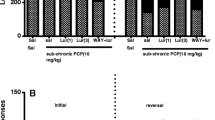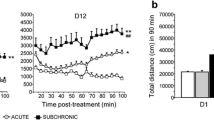Abstract
Rational
In humans, the N-methyl-d-aspartate antagonist phencyclidine (PCP) induces behavioral changes that mimic schizophrenia symptoms, including positive and negative symptoms as well as cognitive deficits. In clinic, the cognitive deficits are closely associated with functional outcome. Thus, improvement of cognition may have high impact on patients’ daily life.
Objective
In the present study, three second-generation antipsychotics (sertindole, risperidone, and clozapine) as well as the classical antipsychotic haloperidol were tested for the ability to reverse PCP-induced cognitive deficits in the Morris’ water maze.
Results
The second-generation antipsychotics reversed the PCP-induced cognitive impairment: sertindole (0.63–2.5 mg/kg, s.c.), risperidone (0.04 mg/kg, s.c.; whereas 0.08 and 0.16 mg/kg were without significant effect), and clozapine (0.63 mg/kg, s.c.; while 1.3 mg/kg was without significant effect). The significant effect of sertindole was observed from day 2 onwards, while clozapine and risperidone only had significant effect at day 3. The classical antipsychotic haloperidol (0.010–0.020 mg/kg, s.c.) was ineffective. No compounds influenced swimming speed at the doses used, indicating that motor function was preserved.
Conclusion
These results confirm that repeated PCP administration induces marked cognitive deficits. Further, second-generation antipsychotics like sertindole, clozapine, and risperidone within a certain, often narrow, dose range are able to reverse the impairment and thus might improve cognitive deficits in schizophrenic patients, whereas classical compounds like haloperidol lack this effect. The receptor mechanisms involved in the reversal of PCP’s disruptive effect are discussed and likely include a delicate balance between effects on dopamine D2, 5-HT2A/6, alpha-adrenergic, muscarinic, and histaminergic H1 receptors.



Similar content being viewed by others
References
Abdul M, Reynolds GP, Neill JC (2006) The effect of atypical and classical antipsychotics on sub-chronic PCP-induced cognitive deficits in a reversal-learning paradigm. Behav Brain Res 169:263–273
Addington J, Addington D (1999) Neurocognitive and social functioning in schizophrenia. Schizophr Bull 25:173–182
Arnt J (1995) Differential effects of classical and newer antipsychotics on the hypermotility induced by two dose levels of d-amphetamine. Eur J Pharmacol 283:55–62
Arnt J, Skarsfeldt T (1998) Do novel antipsychotics have similar pharmacological characteristics? A review of the evidence. Neuropsychopharmacology 18:63–101
Bakshi VP, Geyer MA (1997) Phencyclidine-induced deficits in prepulse inhibition of startle are blocked by prazosin, an alpha-1 noradrenergic antagonist. J Pharmacol Exp Ther 283:666–674
Boast C, Bartolomeo AC, Morris H, Moyer JA (1999) 5HT antagonists attenuate MK801-impaired radial arm maze performance in rats. Neurobiol Learn Mem 71:259–271
Brewer W, Wood S, Phillips L, Francey S, Pantelis C, Yung A, Cornblatt B, McGorry P (2006) Generalized and specific cognitive performance in clinical high-risk cohorts: a review highlighting potential vulnerability markers for psychosis. Schizophr Bull 32:538–555
Chesler EJ, Salamone JD (1996) Effects of acute and repeated clozapine injections on cholinomimetic-induced vacuous jaw movements. Pharmacol Biochem Behav 54:619–624
Cleghorn JM, Kaplan RD, Szechtman B, Szechtman H, Brown GM (1990) Neuroleptic drug effects on cognitive function in schizophrenia. Schizophr Res 3:211–219
Cutmore TRH, Beninger RJ (1990) Do neuroleptics impair learning in schizophrenic patients. Schizophr Res 3:173–186
D’Hooge R, De-Deyn PP (2001) Applications of the Morris water maze in the study of learning and memory. Brain Res Brain Res Rev 36:60–90
Dawson LA, Nguyen HQ, Li P (2001) The 5-HT(6) receptor antagonist SB-271046 selectively enhances excitatory neurotransmission in the rat frontal cortex and hippocampus. Neuropsychopharmacology 25:662–668
Didriksen M (1995) Effects of antipsychotics on cognitive behaviour in rats using the delayed non-match to position paradigm. Eur J Pharmacol 281:241–250
Didriksen M, Kreilgaard M, Arnt J (2006) Sertindole, in contrast to clozapine and olanzapine, does not disrupt water maze performance after acute or chronic treatment. Eur J Pharmacol 542:108–115
Diehl K-H, Hull R, Morton D, Pfister R, Rabemampianina Y, Smith S, Vidal J-M, Van De Vorstenbosch C (2001) A good practice guide to the administration of substances and removal of blood, including routes and volumes. J Appl Toxicol 21:15–23
Fitton A, Heel RC (1990) Clozapine. A review of its pharmacological properties, and therapeutic use in schizophrenia. Drugs 40:722–747
Fulton B, Goa KL (1997) Olanzapine, a review of its pharmacological properties and therapeutic efficacy in the management of schizophrenia and related psychoses. Drugs 53:281–298
Gleason SD, Shannon HE (1997) Blockade of phencyclidine-induced hyperlocomotion by olanzapine, clozapine and serotonin receptor subtype selective antagonists in mice. Psychopharmacology 129:79–84
Goldberg TE, Ragland D, Torrey EF, Gold JM, Bigelow LB, Weinberger DR (1990) Neuropsychological assessment of monozygotic twins discordant for schizophrenia. Arch Gen Psychiatry 47:1066–1072
Goldberg TE, Greenberg RD, Griffin SJ, Gold JM, Kleinman JE, Pickar D, Schulz SC, Weinberger DR (1993) The effect of clozapine on cognition and psychiatric symptoms in patients with schizophrenia. Br J Psychiatry 162:43–48
Green MF (1996) What are the functional consequences of neurocognitive deficits in schizophrenia? Am J Psychiatry 153:321–330
Green MF, Kern RS, Braff DL, Mintz J (2000) Neurocognitive deficits and functional outcome in schizophrenia: are we measuring the “right stuff”? Schizophr Bull 26:119–136
Harvey PD, Parrella M, White L, Mohs RC, Davidson M, Davis KL (1999) Convergence of cognitive and adaptive decline in late-life schizophrenia. Schizophr Res 35:77–84
Hashimoto K, Fujita Y, Shimizu E, Iyo M (2005) Phencyclidine-induced cognitive deficits in mice are improved by subsequent subchronic administration of clozapine, but not haloperidol. Eur J Pharmacol 519:114–117
Hatcher P, Brown V, Tait D, Bate S, Overend P, Hagan J, Jones D (2005) 5-HT6 receptor antagonists improve performance in an attentional set shifting task in rats. Psychopharmacology 181:253–259
Hertel P, Fagerquist MV, Svensson TH (1999) Enhanced cortical dopamine output and antipsychotic-like effects of raclopride by alpha2 adrenoceptor blockade. Science 286:105–107
Hirst W, Stean T, Rogers D, Sunter D, Pugh P, Moss S, Bromidge S, Riley G, Smith D, Bartlett S, Heidbreder C, Atkins A, Lacroix L, Dawson L, Foley A, Regan C, Upton N (2006) SB-399885 is a potent, selective 5-HT6 receptor antagonist with cognitive enhancing properties in aged rat water maze and novel object recognition models. Eur J Pharmacol 553:109–119
Hoff AL, Faustman WO, Wieneke M, Espinoza S, Costa M, Wilkowitz O, Csernansky JG (1996) The effect of clozapine on symptom reduction, neurocognitive function, and clinical management in treatment-refractory state hospital schizophrenic inpatients. Neuropsychopharmacology 15:361–369
Idris NF, Repeto P, Neill JC, Large CH (2005) Investigation of the effects of lamotrigine and clozapine in improving reversal-learning impairments induced by acute phencyclidine and d-amphetamine in the rat. Psychopharmacology 179:336–348
Javitt DC, Zukin SR (1991) Recent advances in the phencyclidine model of schizophrenia. Am J Psychiatry 148:1301–1308
Jentsch JD, Roth RH (1999) The neuropsychopharmacology of phencyclidine: from NMDA receptor hypofunction to the dopamine hypothesis of schizophrenia. Neuropsychopharmacology 20:201–225
Kane JM, Tamminga CA (1997) Sertindole (serdolect): preclinical and clinical findings of a new atypical antipsychotic. Expert Opin Investig Drugs 6:1729–1741
Kapur S, Zipursky RB, Remington G (1999) Clinical and theoretical implications of 5-HT2 and D2 receptor occupancy of clozapine, risperidone, and olanzapine in schizophrenia. Am J Psychiatry 156:286–293
Lacroix L, Dawson L, Hagan J, Heidbreder C (2004) 5-HT6 receptor antagonist SB-271046 enhances extracellular levels of monoamines in the rat medial prefrontal cortex. Synapse 51:158–164
Leysen JE (2000) Receptor profile of antipsychotics. In: Ellenbroek BA, Cools AR (eds) Atypical antipsychotics. Milestones in drug therapy. Birkhäuser Verlag, Basel, pp 57–81
Lis S, Krieger S, Gallhofer B, Torre P, Mittoux A, Menard F (2003) Sertindole is superior to haloperidol in cognitive performance in patients with schizophrenia: a comparative study. Eur Neuropsychopharmacol 13:S323–S324
Marcus M, Jardemark K, Wadenberg M, Langlois X, Hertel P, Svensson T (2005) Combined alpha2 and D2/3 receptor blockade enhances cortical glutamatergic transmission and reverses cognitive impairment in the rat. Int J Neuropsychopharmacol 8:315–327
Marrs W, Kuperman J, Avedian T, Roth R, Jentsch J (2005) Alpha-2 adrenoceptor activation inhibits phencyclidine-induced deficits of spatial working memory in rats. Neuropsychopharmacology 30:1500–1510
Mathé JM, Nomikos GG, Hildebrand BE, Hertel P, Svensson TH (1996) Prazosin inhibits MK-801-induced hyperlocomotion and dopamine release in the nucleus accumbens. Eur J Pharmacol 309:1–11
Meltzer HY, McGurk SR (1999) The effects of clozapine, risperidone, and olanzapine on cognitive function in schizophrenia. Schizophr Bull 25:233–255
Morris RGM (1984) Developments of a water-maze procedure for studying spatial learning in the rat. J Neurosci Methods 11:47–60
Mortimer AM (1997) Cognitive function in schizophrenia—do neuroleptics make a difference? Pharmacol Biochem Behav 56:789–795
Natesan S, Reckless G, Nobrega J, Fletcher P, Kapur S (2006) Dissociation between in vivo occupancy and functional antagonism of dopamine D2 receptors: comparing aripiprazole to other antipsychotics in animal models. Neuropsychopharmacology 31:1854–1863
Nuechterlein KH, Robbins TW, Einat H (2005) Distinguishing separable domains of cognition in human and animal studies: what separations are optimal for targeting interventions? A summary of recommendations from breakout group 2 at the measurement and treatment research to improve cognition in schizophrenia new approaches conference. Schizophr Bull 31:870–874
Okamura N, Yanai K, Higuchi M, Sakai J, Iwata R, Ido T, Sasaki H, Watanabe T, Itoh M (2000) Functional neuroimaging of cognition impaired by a classical antihistamine, d-chlorpheniramine. Br J Pharmacol 129:115–123
Podhorna J, Didriksen M (2005) Performance of male C57BL/6J mice and Wistar rats in the water maze following various schedules of phencyclidine treatment. Behav Pharmacol 16:25–34
Riekkinen P Jr, Sirviö J, Aaltonen M, Riekkinen P (1990) Effects of concurrent manipulations of nicotinic and muscarinic receptors on spatial and passive avoidance learning. Pharmacol Biochem Behav 37:405–410
Rodefer JS, Nguyen TN, Arnt J (2006) The effects of antipsychotics on cognitive deficits produced by subchronic PCP administration in a rodent attentional ED/ID set-shifting task. Int J Neuropsychopharmacol 9(S1):S140
Sams-Dodd F (1997) Effect of novel antipsychotic drugs on phencyclidine-induced stereotyped behaviour and social isolation in the rat social interaction test. Behav Pharmacol 8:196–215
Sevy S, Davidson M (1995) The costs of cognitive impairment in schizophrenia. Schizophr Res 17:1–3
Siegel S (1956) Nonparametric statistics for the behavioral sciences. McGraw-Hill, New York
Skarsfeldt T (1996) Differential effect of antipsychotics on place navigation of rats in the Morris water maze. Psychopharmacology 124:126–133
Tamminga CA, Mack RJ, Granneman GR, Silber CJ, Kashkin KB (1997) Sertindole in the treatment of psychosis in schizophrenia: efficacy and safety. Int Clin Psychopharmacol 12(Suppl 1):S29–S35
Tashiro M, Mochizuki H, Iwabuchi K, Sakurada Y, Itoh M, Watanabe T, Yanai K (2002) Roles of histamine in regulation of arousal and cognition: functional neuroimaging of histamine H1 receptors in human brain. Life Sci 72:409–414
Tollefson GD (1996) Cognitive function in schizophrenic patients. J Clin Psychiatry 57:31–39
Varty GB, Bakshi VP, Geyer MA (1999) M100907, a serotonin 5-HT2A receptor antagonist and putative antipsychotic, blocks dizocilpine-induced prepulse inhibition deficits in Sprague–Dawley and Wistar rats. Neuropsychopharmacology 20:311–321
Velling DI, Mahurin RK, Diamond PL, Hazleton BC, Eckert SL, Miller AL (1997) The functional significance of symptomatology and cognitive function in schizophrenia. Schizophr Res 25:21–31
Weinberger DR, Gallhofer B (1997) Cognitive function in schizophrenia. Int Clin Psychopharmacol 12:S29–S36
Weiner DM, Meltzer HY, Veinbergs I, Donohue EM, Spalding TA, Smith TT, Mohell N, Harvey SC, Lameh J, Nash N, Vanover KE, Olsson R, Jayathilake K, Lee M, Levey AI, Hacksell U, Burstein ES, Davis RE, Brann MR (2004) The role of M1 muscarinic receptor agonism of N-desmethylclozapine in the unique clinical effects of clozapine. Psychopharmacology 177:207–216
Woolley ML, Marsden CA, Fone KCF (2004) 5-HT(6) receptors. Curr Drug Targets CNS Neurol Dis 3:59–79
Zorn SH, Jones SB, Ward KM, Liston DR (1994) Clozapine is a potent and selective muscarinic M4 receptor agonist. Eur J Pharmacol 269:R1–R2
Acknowledgement
The authors would like to thank Birgitte Bjørkenberg, Marlene Quvang Jørgensen, and Maj-Britt Filsø Mathiassen for their excellent technical assistance in conducting these experiments.
All experiments were conducted in accordance with the Danish animal protection law.
Author information
Authors and Affiliations
Corresponding author
Rights and permissions
About this article
Cite this article
Didriksen, M., Skarsfeldt, T. & Arnt, J. Reversal of PCP-induced learning and memory deficits in the Morris’ water maze by sertindole and other antipsychotics. Psychopharmacology 193, 225–233 (2007). https://doi.org/10.1007/s00213-007-0774-3
Received:
Accepted:
Published:
Issue Date:
DOI: https://doi.org/10.1007/s00213-007-0774-3




